
Structural Design
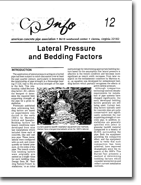 |
Lateral Pressure and Bedding Factors Resource # CP-02-711 This paper discusses the limitations of early research by Marston and Spangler with respect to bedding factors. This is one element of SIDD (Standard Installations Direct Design), the innovative concrete pipe design method recommended by the American Concrete Pipe Association. This document presents a method for determining bedding factors for the three historical beddings, taking into consideration lateral forces and modern installation methods. |
||
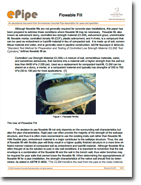 |
Flowable Fill Resource # e-010 Although flowable fills are not generally required for concrete pipe installations, this paper has been prepared to address those conditions where flowable fill may be necessary. |
||
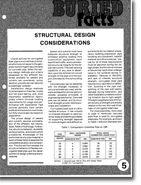 |
Structural Design Considerations The proper design of sewers and culverts requires consideration of the different, but interrelated, fields of hydrology, hydraulics, structural behavior, durability, economics and construction procedures. This Buried Fact reviews the structural behavior of flexible steel pipe and the development of design criteria and procedures. |
||
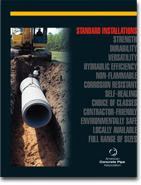 |
Standard Installations Resource # 07-126 The four zones (middle bedding, outer bedding, haunch, and lower side) are shown along with installation types based on soil characteristics and levels of compaction and the material used in construction of these zones. Member price: $37.50 / package of 25 Non-member price: $75.00 / package of 25 Order Now |
||
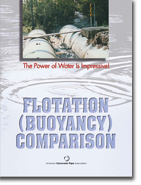 |
Flotation (Buoyancy) Comparison Resource # 07-125 Buoyancy forces that affect a buried pipeline should always be a design consideration, especially in site conditions with a high probability of flotation. This brochure explains the average density of concrete pipe as compared to corrugated PE pipe. The proof is in the pictures of this brochure that show jetting or collapse of high density polyethylene culverts and the roadways because of flotation. Member price: $25.00 / package of 25 Non-member price: $50.00 / package of 25 Order Now |
||
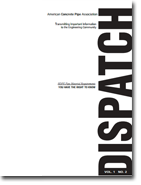 |
HDPE Pipe Material Requirements — YOU HAVE THE RIGHT TO KNOW Dispatch – Volume 1, Number 2 AASHTO Bridge Engineers Approve Recommendations of NCHRP Report 429 On June 8th, 2000, at their annual meeting. This was done despite the protests of CPPA/PPI during the previous year and CPPA’s/PPI’s efforts to obscure the issue with tests and reports of their own. |
||
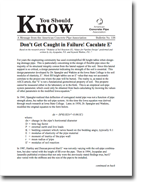 |
Don’t get caught in failure! Calculate ‘E’ (YSK Bulletin #138) April, 2006 For years the engineering community has used oversimplified fill height tables when designing drainage pipe. Taking E’ values from the design guides or simple consensus standards of the pipe vendor should be avoided. If you have never worked with E’ values before, consult an expert! |
||
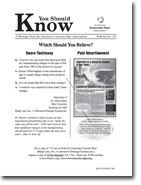 |
Which Should You Believe? — Sworn Testimony vs. Paid Advertisement (YSK Bulletin #127) July, 2003 Dr. Hazen’s testimony clearly points out that high-density polyethylene pipe is not “made the same way, all the time.” There have been at least four significant changes in the manufacturing specification for N-12 pipe within the past seven years – that we know of! |
||
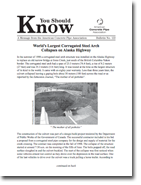 |
World’s Largest Corrugated Steel Arch Collapses on Alaska Highway (YSK Bulletin 122) August, 2002 “Largest structure of its kind in the world.” “The mother of all potholes.” How about “largest collapse”? Luckily this failure occurred during daylight hours or the results could have been tragic. The cause of the failure is still being investigated but we know that a tender for a new concrete bridge to replaced the failed structure was accepted at $1.88 million. Read about the effects that a catastrophic failure can have on the community, residents and traveling public. |
||
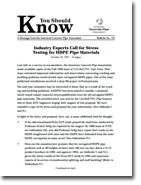 |
Industry Experts Call for Stress Testing for HDPE Pipe Materials (YSK Bulletin 112) December, 1997 Last fall, as a service to our members, the American Concrete Pipe Association made available copies of the Fall 1996 issue of Uni-Bell PVC Pipe News. This issue contained important information and observations concerning cracking and buckling problems involved with some corrugated HDPE pipes. One of the most publicized installations involved a deep-fill project in Pennsylvania. This bulletin contains additional “food for thought” as well as numerous examples an attachments. |
||
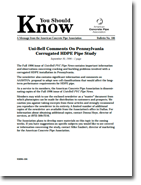 |
Uni-Bell Comments On Pennsylvania Corrugated HDPE Pipe Study (YSK Bulletin 106) September, 1996 The Fall 1996 issue of Uni-Bell PVC Pipe News contains important information and observations concerning cracking and buckling problems involved with a corrugated HDPE installation in Pennsylvania. As a service to its members, the American Concrete Pipe Association is disseminating copies of the Fall 1996 issue of Uni-Bell PVC Pipe News. |
||
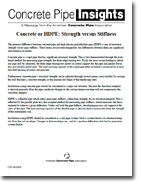 |
Concrete or HDPE: Strength versus Stiffness CP Insights 4 The primary difference between concrete pipe and high density polyethylene pipe (HDPE is one of structural strength versus pipe stiffness. These terms are not interchangeable: the differences between them are significant and technical in nature. |
||